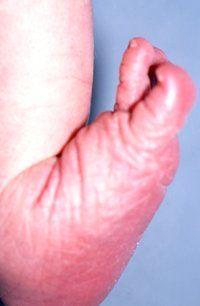Talipes calcaneovalgus
A newborn girl was noted to have talipes calcaneovalgus, excessive dorsiflexion of the foot that allows its dorsum to come into contact with the anterior aspect of the lower leg- the toes point upward, the arch is flat. The right foot was normal. The infant had no other abnormalities.
A newborn girl was noted to have talipes calcaneovalgus, excessive dorsiflexion of the foot that allows its dorsum to come into contact with the anterior aspect of the lower leg- the toes point upward, the arch is flat. The right foot was normal. The infant had no other abnormalities. She was born vaginally at 38 weeks’ gestation without complications. Prenatal history was unremarkable.

Calcaneovalgus is a relatively common finding in newborns. The incidence of severe calcaneovalgus is between 0.4 and 1 per 1000 live births1; lesser degrees of the deformity occur in 5% of all newborns.2 It is more common in female newborns and in breech deliveries and can be unilateral or bilateral.
Calcaneovalgus results from uterine positioning. The plantar surface of the foot is against the wall of the uterus, which forces the foot into dorsiflexion. Affected newborns have external rotation of the calcaneus, overstretched Achilles tendon, and tight leg musculature.2 The foot can be plantarflexed to only 90 degrees or less. Calcaneovalgus can be associated with hip dysplasia and external rotation of the tibia (with the toes pointing outward) or posteromedial bowing of the tibia, which may lead to a leg length discrepancy.
The differential diagnosis includes congenital vertical talus, also known as rocker-bottom foot, in which the foot is fixed in plantarflexion with a reversed arch. Infants with this rare anomaly almost always require surgery. Initial treatment with a long leg cast is recommended. Lateral foot radiographs can help differentiate between calcaneovalgus and congenital vertical talus.
Although some experts feel that calcaneovalgus deformities resolve spontaneously,3,4 gentle plantar flexion stretching with mild inversion of the foot repeated 10 times a day or with each diaper change can help. This infant’s parents gently massaged the foot several times daily and noted virtual normal appearance after 6 weeks. Complete resolution can be expected within 3 to 6 months. In severe cases, splinting, firm high-top shoes, or serial casting followed by nighttime splinting in the corrected position for 2 to 10 weeks may be required.5
References:
REFERENCES:
1. Taeusch WH, Ballard RA, Gleason CA, eds. Avery’s Diseases of the Newborn. 8th ed. Philadelphia: Elsevier Saunders; 2005:1427.
2. Gore AI, Spencer JP. The newborn foot. Am Fam Physician. 2004;69:865-872.
3. Hoffinger SA. Evaluation and management of pediatric foot deformities. Pediatr Clin North Am. 1996;43:1091-1111.
4. Wall EJ. Practical primary pediatric orthopedics. Nurs Clin North Am. 2000;35:95-113.
5. Connors JF, Werrick E, Lowy LJ, et al. Guidelines for evaluation and management of five common podopediatric conditions. J Am Podiatr Med Assoc. 1998;88:206-222.